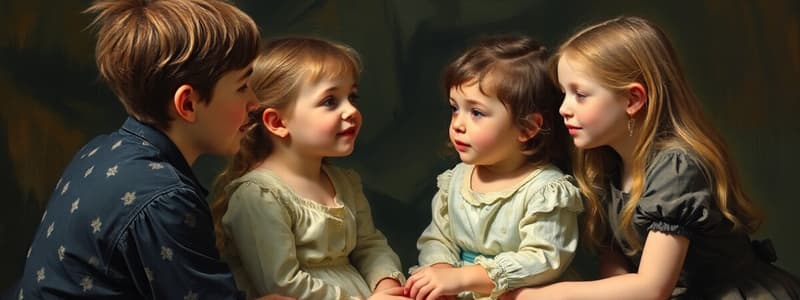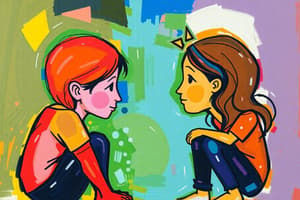Podcast
Questions and Answers
Why are positive adult-child relationships considered vital in mixed-age school-age care programs?
Why are positive adult-child relationships considered vital in mixed-age school-age care programs?
In what way do mixed-age groupings primarily contribute to a child's experience of diversity?
In what way do mixed-age groupings primarily contribute to a child's experience of diversity?
Which of the following strategies is LEAST likely to help adults build positive relationships with children in after-school programs?
Which of the following strategies is LEAST likely to help adults build positive relationships with children in after-school programs?
How do friendships primarily contribute to the social-emotional development of school-age children?
How do friendships primarily contribute to the social-emotional development of school-age children?
What is a key benefit of allowing after-school programs the flexibility to group and regroup children?
What is a key benefit of allowing after-school programs the flexibility to group and regroup children?
If a school-age care program aims to foster authentic inclusiveness through mixed-age grouping, what initial step should the staff prioritize?
If a school-age care program aims to foster authentic inclusiveness through mixed-age grouping, what initial step should the staff prioritize?
Which of the following best describes how after-school staff can effectively promote cross-age teaching and learning?
Which of the following best describes how after-school staff can effectively promote cross-age teaching and learning?
What outcome is MOST likely for children who have positive relationships with adult role models, compared to those who do not?
What outcome is MOST likely for children who have positive relationships with adult role models, compared to those who do not?
Which of the following best describes how friendships evolve as children age?
Which of the following best describes how friendships evolve as children age?
What is a key characteristic of friendships formed during the stage of shared values and rules?
What is a key characteristic of friendships formed during the stage of shared values and rules?
How can intentional instruction in the arts positively influence children's cognitive abilities?
How can intentional instruction in the arts positively influence children's cognitive abilities?
Which of the following is an example of how visual arts can aid children who struggle with expressing their feelings verbally?
Which of the following is an example of how visual arts can aid children who struggle with expressing their feelings verbally?
What is a significant benefit of interpretive dance for school-age children?
What is a significant benefit of interpretive dance for school-age children?
How can playing a musical instrument benefit school-age children socially and emotionally?
How can playing a musical instrument benefit school-age children socially and emotionally?
What role do song lyrics play in helping school-age children through different situations?
What role do song lyrics play in helping school-age children through different situations?
How can acting and storytelling support children's emotional development?
How can acting and storytelling support children's emotional development?
In what way does pretend play serve as a healthy outlet for school-age children?
In what way does pretend play serve as a healthy outlet for school-age children?
What is the primary goal of incorporating different content areas through social experiences, as mentioned?
What is the primary goal of incorporating different content areas through social experiences, as mentioned?
What does culturally responsive experiences offer to children in a program?
What does culturally responsive experiences offer to children in a program?
Why is it important to offer a broad definition of 'culture' in creative programs for children?
Why is it important to offer a broad definition of 'culture' in creative programs for children?
What should you do to support children who have difficulties accessing creative artistic experiences?
What should you do to support children who have difficulties accessing creative artistic experiences?
What is the role of music composition, such as writing song lyrics, in the social-emotional development of school-age children?
What is the role of music composition, such as writing song lyrics, in the social-emotional development of school-age children?
How might access to creative experiences need to be adjusted for a child who uses a wheelchair?
How might access to creative experiences need to be adjusted for a child who uses a wheelchair?
Flashcards
Mixed-Age Grouping
Mixed-Age Grouping
Grouping children of different ages together in activities or learning environments.
Cross-Age Teaching and Learning
Cross-Age Teaching and Learning
The give-and-take of knowledge and skills between children of different ages.
Cooperative Learning
Cooperative Learning
Learning through cooperation and collaboration with others.
Positive Adult-Child Relationships
Positive Adult-Child Relationships
Signup and view all the flashcards
Importance of Friendships
Importance of Friendships
Signup and view all the flashcards
Friendship: Companionship
Friendship: Companionship
Signup and view all the flashcards
Friendship: Confidant
Friendship: Confidant
Signup and view all the flashcards
Friendship: Allies
Friendship: Allies
Signup and view all the flashcards
Friendship Support
Friendship Support
Signup and view all the flashcards
Early Friendships
Early Friendships
Signup and view all the flashcards
Later Childhood Friendships
Later Childhood Friendships
Signup and view all the flashcards
Cliques
Cliques
Signup and view all the flashcards
The Arts
The Arts
Signup and view all the flashcards
Benefits of Arts Education
Benefits of Arts Education
Signup and view all the flashcards
Visual Arts
Visual Arts
Signup and view all the flashcards
Interpretive Dance
Interpretive Dance
Signup and view all the flashcards
Music
Music
Signup and view all the flashcards
Drama
Drama
Signup and view all the flashcards
Acting and Storytelling
Acting and Storytelling
Signup and view all the flashcards
Pretend Play
Pretend Play
Signup and view all the flashcards
Culturally Responsive Experiences
Culturally Responsive Experiences
Signup and view all the flashcards
Defining Culture
Defining Culture
Signup and view all the flashcards
Accessible Creative Experiences
Accessible Creative Experiences
Signup and view all the flashcards
Study Notes
- Mixed-age groupings in school-age care create opportunities for cross-age instruction and cooperative learning.
- Flexible after-school programs can dynamically group children of different developmental levels, interests, skills, and learning styles, promoting diversity and inclusiveness.
- Positive adult-to-child relationships built on mutual respect are vital for creating a supportive environment, reducing stress, improving academic achievement, and fostering healthier peer relationships.
- Adults can build positive relationships by making children feel welcome, recognizing their accomplishments, treating them with respect, actively listening, responding with interest, and being consistent.
Positive Peer Relationships
- Friendships broaden horizons, create self-image and social support systems
- Establishing and maintaining friendships is a key goal of social-emotional development
- Friendships provide companionship, confidants, allies, and support.
- Early friendships in school involve shared interests and convenience
- Older children's friendships involve shared values and rules.
- Children form larger peer groups in pre-teen years
- Groups can highly influence each other.
Key Content Areas
- Arts
- Math, science, cooking and nutrition
- Large and small muscle motor activities
- Social studies
- Language and literacy
- Social-emotional development
- The goal is not to replace school instruction but to include content through meaningful social experiences.
The Arts
- The arts encompass creative expression, storytelling, and cultural participation
- Children who have intentional instruction in the arts display more creativity, accept criticism better, ask more "what if" questions, talk more freely, use descriptive language, have enhanced spatial reasoning, solve problems better, have more self-esteem, and encourage freedom of expression.
Domains of the Arts
Visual Arts
- Includes self-expression, visual and tactile art, print and craft media, analysis, and interpretation.
- School-age children can create images or visual representations of events or feelings
- Allows children to express complex feelings without always having to discuss them directly.
Dance
- Includes body awareness, fundamentals of movement, creative expression, and multisensory integration.
- Interpretive dance allows expression of emotions through movement.
Music
- Includes sound, pitch, rhythm, singing, playing, musical games, listening, and creative movement.
- Playing a musical instrument allows for creative expression of feelings.
- Music composition allows expression of emotions and feelings via song lyrics.
- Listening to music serves as a great outlet as children can express their mood
Drama
- Includes acting, pantomime, improvisation, characterization, and play production.
- Acting and storytelling allows a child to express emotion
- Pretend play is a healthy form of escape from daily stressors
Culturally Responsive Experiences
- Culturally responsive experiences help children see themselves represented in the program.
- Important to expose children to people, ideas, and experiences worldwide.
- Provide inclusive experiences that help children define a sense of self, family values, beliefs, or experiences.
- Art and creative experiences should always be a choice, and there should be no wrong answers.
- Each child encounters experiences in their own way and at their own pace.
Studying That Suits You
Use AI to generate personalized quizzes and flashcards to suit your learning preferences.
Description
Mixed-age groupings promote cross-age instruction and diversity in after-school programs. Positive adult-child relationships built on respect foster a supportive environment, reduce stress, and improve academic achievement. Early friendships broaden horizons and create social support systems.




